The Prayer of the Orchard Street Shul
In America it happens all the time. Immigrant Jews arrive, build a community, more Jews come, and then prosper and move on to a better neighborhood and finally the suburbs. In the old neighborhood non-Jewish immigrants take their places and suddenly the once-thriving shuls are empty.
Some are abandoned, sold to churches, developers or urban renewal knocks down the rest. Beth Israel Synagogue in New Haven, Connecticut, known as the Orchard Street Shul, is the last shul standing out of the former 20 synagogues in New Haven. It stands at a historic crossroads; less and less able to muster a minyan and maintain its building and yet not willing to abandon its home of 82 years.
Rabbi Mendy Hecht asked new-media artist Cynthia Beth Rubin to organize an art exhibition to help bring people to the shul. From this simple request the Cultural Heritage Artists Project was born. Perhaps making art and raising public consciousness of the cultural heritage about to be lost could infuse the shul and congregation with a new life and hopeful future. CHAP aims to create a historical narrative that will “document, interpret and retell [the] cultural legacy of the Orchard Street Shul.” Quickly this developed into a hybrid collaborative project involving artists who first visited the shul, interacted with the congregation and finally set out to make specific artworks that somehow reflected their ideas and experience of the Orchard Street Shul. Their efforts are on view at the John Slade Ely House Center for Contemporary Art from December 6 until January 31, 2010 accompanied by a series of 5 panel discussions to explore various aspects of the Project.
While all 28 artists use images in one form or another from the Shul itself and are concerned with various aspects of memory, their responses can be divided into two categories: personal and universal. Here is a selection from this powerful and thought provoking exhibition:
Julian Voloj presented The Beth Israel Triptych consisting of sculpture (Remembrance Stones), screenshots (Virtual Realities) and photographs (The Incomplete Minyan). The Incomplete Minyan is perhaps the most moving evocation of the present condition; half the photos are of individual congregants while the remaining five are objects in the shul and gravestones. For a shul to constantly struggle to get a minyan is like a person gasping for breath.
Another aspect of personal reflection is Robert Rattner’s photographs that explore the worn symbols of this Jewish community, especially the Star of David. His C Prints, especially the one of a worker glimpsed in pew wearing overalls and pink plastic gloves provides a shock of irreverent contrasts.
Roslyn Croog took 9 pages of the Gemara in Succah and utilized their textual patterns and page numbers to express her deep familial connection to the shul. She grew up in the congregation her grandparents helped found and the artist experienced the shul as a metaphoric succah; a sheltering oasis in her life. In these digital images different aspects of the shul are merged with the Talmudic text presenting a kind of transformation of oral law into a visual memorial.
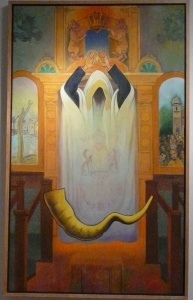
While not native to New Haven, Alan Falk’s painting Tekiah summons a pervasive memory of this congregation; the blowing of the shofar and the Priestly Blessing on Rosh HaShanah. The painting conflates images of the Orchard Street Shul’s ark, animating the sculpted priestly hands blessing as a ghost-like Cohen emerges from the Torah curtains and confronts a shofar floating in the foreground, perhaps transforming the blessing of peace into a blessing promising future shofar blasts to be heard in this shul. Alas, Falk’s painting cannot but recognize the harsh reality of the shul as the side windows represent the shul once filled is now desolate and the rampant lions guard an empty pair of tablets. A more poignant New Year blessing could not be found.
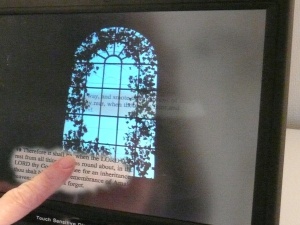
Other artists have more distance, such as Remembering and Forgetting by Greg Garvey, an interactive image on a computer touch sensitive display panel. His work is subtly deceptive, presenting a fixed image of the synagogue window with garlands of fall leaves in silhouette, at first enticing the viewer to touch the screen and summoning the English and Hebrew texts of Exodus 25:17-19; the awesome command to remember Amalek, never forget. The text of course drives us to remember all our oppressors, all those who would attack and destroy our people and our congregations. This is exactly the challenge the Orchard Street Shul is facing. But the artwork taunts us because exactly at the moment we touch the screen to summon the biblical text, it partially appears and then disappears, our hopes dashed, our faith sorely tested.
The efforts to evoke memory of the shul’s cultural heritage also demand documentation of what is there now. Chen Xu and Holly Rushmeier from the Yale Graphics Group present a rotating image of the shul floating in the blackness of digital space. The video was made using 3D laser range scans, digital photographs and traditional measurements. We see the four exterior walls with the two levels of windows, the interior, pews, bimah and aron rotate around and around, then flipped over head to toe and side to side. To be able to visually explore this beloved space from every conceivable angle is an eloquent illusion of actually possessing the building made all the more ironic due to the challenging future it faces.
Lamentations, a video created by Shalom Gorewitz with Karen Schiff, explores the emotions this suffering congregation experiences. Filmed during a thunder storm the day before Tisha b’Av we see Schiff wandering through the empty and deteriorating shul; finding herself on the bimah she weaves verses from Lamentations with her own reflections: “lonely is the city… an empty shul… Jerusalem destroyed. Bitterly she weeps in the night there is none to comfort her. Who will stand and comfort with me… who will keep company with the 8th of Av… this building?” For these artists simply being in the shul is almost too much to bear. They do not focus on memory that might provide a substance to rebuild, rather the pain of imminent loss obscures all else.
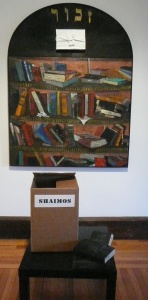
Janet Shafner creates a somber installation with Zachor. The upper lunette features a book neatly wrapped and tied, evoking our supernal desires, zachor… remember us for life. The square painting in the middle depicts a motley collection of old books, scraps of paper, every color and shape of fragments. These are in some sense the mundane life of the Jews as it was left behind in the shul. And finally standing on a low table a shaimos box alongside some ruined books, unopenable and useless. It stands for our fears that this is what we shall become, useless and ready to be buried with the rest of the Jewish dead.
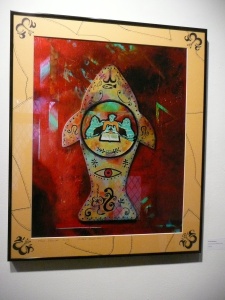
This thought-provoking exhibition has its hopeful moments, especially found in Yona Verwer’s Temple Talismans: Orchard Street Shul Amulets. Her works are “derived from the Kabalistic notion of Tikkun and the idea that the world is broken and can be fixed only by human acts.” One thing we can do is to draw positive energy into the building and those helping by the use of amulets, traditional Jewish mystical icons that affect the supernal realms. Her fish amulet utilizes symbols of prosperity, (the fish) the all-seeing eye along with images from the shul’s own ark. Her bright colors likewise contradict the bland bleakness she experienced in the shul’s interior.
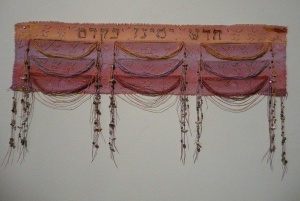
Finally a work that seems to summarize all of the yearnings the Cultural Heritage Artists Project is found in Laurie Wohl’s wall hanging, Hadeish Yameinu Ke’kedem. Her beautifully sumptuous fabric alive with little dancing figures, perhaps angels, perhaps joyous Jews, is a fitting foundation to our proclamation of faith and love found at the very end of Lamentations (5:21), “Bring us back to You, Lord, and we shall return, renew our days as of old.”
The genius of this exhibition, conceived and organized by Cynthia Beth Rubin, is that it simulated artists to create works specific to the shul and its history, documenting the cultural heritage of the Orchard Street Shul by means of a chorus of artworks that join together in a prayer of art: “Bring us back to You, Lord, and we shall return, renew our days as of old.”
The Prayer of the Orchard Street Shul
John Slade Ely House Center for Contemporary Art
51 Trumbull Street, New Haven, CT
Elyhouse.org